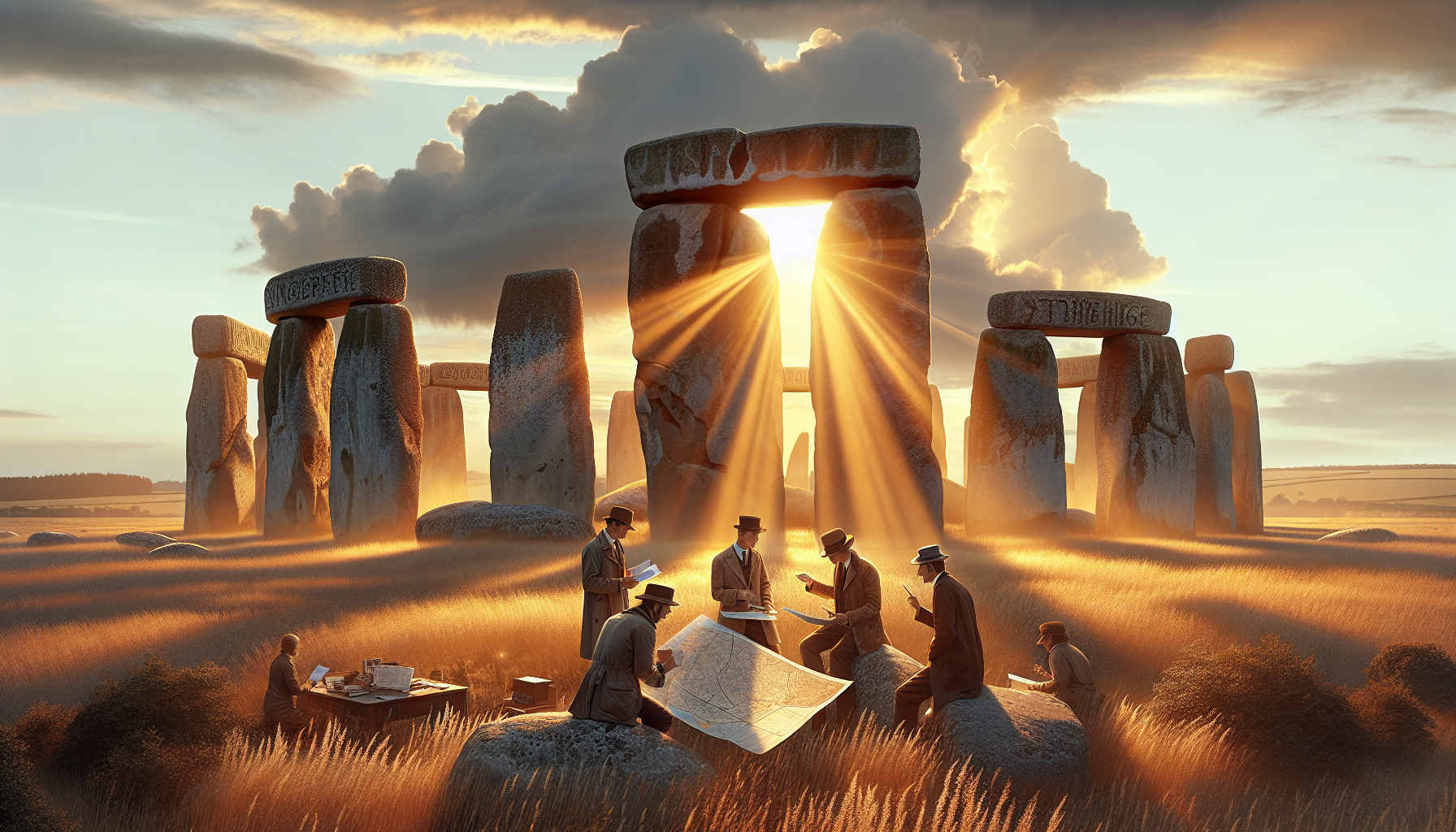For centuries, Stonehenge has stood as a sentinel of mystery, a monumental enigma nestled in the heart of the English countryside. This ancient stone circle, with its towering sarsens and meticulously placed bluestones, has captivated historians, archaeologists, and curious minds alike, sparking countless theories about its purpose and construction. As the sun rises and sets, casting shadows that dance across the Salisbury Plain, one cannot help but wonder: What secrets do these stones hold? Why were they arranged in such precise alignments? And what can they tell us about the people who toiled to erect them millennia ago? Today, we embark on a journey to unlock the mysteries of Stonehenge, decoding its ancient alignments to gain a deeper understanding of this iconic landmark. 🌄
In this exploration, we will delve into the latest research and discoveries that shed light on Stonehenge’s architectural genius and astronomical significance. From its origins in the Neolithic period to the advanced theories suggesting its role as an ancient calendar or a site for celestial worship, each stone tells a story waiting to be uncovered. We will examine the meticulous planning and laborious efforts that went into transporting these massive stones over great distances, as well as the sophisticated engineering techniques employed to erect them. Furthermore, we’ll explore the spiritual and cultural context of Stonehenge, looking at how it served as a gathering place for rituals and ceremonies that connected the ancient people with the cosmos. Through the lens of modern technology, such as ground-penetrating radar and 3D modeling, we can now peer beneath the surface and reconstruct the site’s evolution over thousands of years.
As we journey through the pages of history and unravel the mysteries of Stonehenge, we will not only gain insights into the architectural prowess and astronomical knowledge of our ancestors but also reflect on the enduring allure of this prehistoric monument. How does Stonehenge continue to inspire and intrigue us in the modern era? What lessons can we draw from the ancient alignments that may apply to our own lives? Join us as we decode the secrets etched in stone, connecting the past and present in a tapestry of wonder and discovery. Let’s uncover the legacy of Stonehenge, a testament to human ingenuity and the timeless quest to understand our place in the universe. 🌌
The Enigma of Stonehenge: An Overview
Stonehenge has captivated the human imagination for centuries. Situated in the English countryside, this prehistoric monument consists of a ring of standing stones, each weighing around 25 tons. The construction methods, purpose, and significance of Stonehenge have been the subject of much speculation and scholarly debate. It’s widely accepted that the structure was erected between 3000 BC and 2000 BC, but its exact function remains a mystery. Archaeologists and historians have proposed a myriad of theories, ranging from astronomical observatory to religious site, and even a place of healing.
One of the most intriguing aspects of Stonehenge is its alignment with the celestial bodies. The monument is precisely oriented toward the sunrise of the summer solstice and the sunset of the winter solstice. This has led many to believe that Stonehenge served as an ancient calendar or observatory. The precision of these alignments suggests a deep understanding of astronomy by the ancient builders, sparking curiosity about the technological capabilities of prehistoric societies. Various studies have attempted to decode these alignments, revealing complex patterns and relationships with other ancient structures.
In addition to its astronomical significance, Stonehenge is a marvel of engineering. The transportation and erection of the massive stones required an incredible amount of effort and coordination. It’s believed that the stones were transported from over 150 miles away, a feat that would have required significant manpower and ingenuity. Researchers continue to uncover new insights into the techniques used by the builders, including the possibility of wooden sledges, rope systems, and even water transport. These discoveries not only shed light on the capabilities of ancient peoples but also inspire awe at their achievements.
The Astronomical Alignments of Stonehenge
Understanding the astronomical alignments of Stonehenge requires a deep dive into the knowledge of celestial events during the era of its construction. The monument’s layout is carefully designed to align with key solar and lunar events. The Heel Stone, for instance, marks the spot where the summer solstice sunrise appears over the horizon. This alignment has been the subject of extensive research, with scientists using modern technology to confirm the precision of these ancient calculations.
The idea of Stonehenge as an astronomical tool is supported by its alignment with lunar cycles. The monument aligns with the major lunar standstills, events that occur approximately every 18.6 years when the moon reaches its northernmost and southernmost points. This suggests that the builders had a sophisticated understanding of both solar and lunar cycles, using Stonehenge as a means to track these celestial events. Such alignments could have been used to predict seasonal changes, aiding in agricultural planning and ceremonial activities.
Research has also revealed that Stonehenge’s design is based on complex geometric principles. The arrangement of the stones forms a series of concentric circles and horseshoe shapes, creating a structure that is both aesthetically pleasing and functionally effective. This geometric precision indicates a high level of mathematical knowledge, further supporting the theory that Stonehenge served as an observatory. As technology advances, new methods of analysis continue to provide fresh insights into the astronomical significance of this ancient monument.
Table: Key Alignments of Stonehenge
| Alignment | Description |
|---|---|
| Summer Solstice Sunrise | Sun rises over the Heel Stone, marking the longest day of the year. |
| Winter Solstice Sunset | Sun sets in alignment with the central Altar Stone, marking the shortest day of the year. |
| Lunar Standstills | Aligns with the major and minor lunar standstills, tracking the moon’s cycle. |
For a deeper understanding of these alignments, watch the video below, which provides a visual exploration of Stonehenge’s astronomical connections.
Stonehenge and the Summer Solstice – English Heritage
Engineering Marvel: How Stonehenge Was Built
The construction of Stonehenge is a testament to the ingenuity and determination of its builders. The sheer size and weight of the stones used in the monument have led to countless theories regarding the methods of transportation and construction. Recent archaeological findings suggest that the sarsen stones, the larger stones used in the outer circle, were likely transported from the Marlborough Downs, about 20 miles to the north. The smaller bluestones are believed to have been sourced from the Preseli Hills in Wales, over 150 miles away.
Researchers have proposed several methods for moving these colossal stones. One prevailing theory involves the use of wooden sledges and rollers, which could have been used to drag the stones across the landscape. Other hypotheses suggest the use of waterways to float the stones closer to the site. Regardless of the exact methods used, it’s clear that the construction of Stonehenge required a well-coordinated effort and considerable resources, suggesting a highly organized society with strong leadership.
Once the stones arrived at the site, they were carefully positioned and erected. The builders employed a sophisticated understanding of engineering principles, using a combination of ramps, levers, and ropes to position the stones upright. The precise interlocking joints and tenons used to secure the lintels on top of the sarsens further demonstrate the builders’ advanced technical skills. This level of craftsmanship is indicative of a society with specialized knowledge and a deep understanding of the physical properties of the materials they were working with.
Table: Construction Techniques Hypotheses
| Technique | Description |
|---|---|
| Wooden Sledges | Stones dragged on sledges over logs acting as rollers. |
| Water Transport | Stones floated down rivers on rafts. |
| Ramps and Levers | Ramps built to elevate stones; levers used for fine positioning. |
For those interested in a visual explanation of these construction theories, check out the following video which delves into the possible methods used by the ancient builders.
How Did They Build Stonehenge? – BBC Earth Lab
The Purpose of Stonehenge: Theories and Speculations
While the construction and alignment of Stonehenge are impressive, the question of its purpose continues to spark debate. Various theories have emerged over the years, each providing a different perspective on the significance of this enigmatic structure. One of the most popular theories is that Stonehenge served as a religious or ceremonial site. The monument’s orientation towards the solstices suggests that it played a role in rituals related to the changing of the seasons. Some researchers believe that Stonehenge was a temple to the sun, used for worship and offerings.
Another intriguing theory posits that Stonehenge functioned as a place of healing. This idea is supported by the discovery of human remains around the site, many of which show signs of illness or injury. Some scholars suggest that people traveled to Stonehenge seeking cures, believing the stones possessed mystical healing properties. The monument’s connection to healing rituals is further reinforced by its alignment with celestial events, which could have been seen as powerful forces capable of influencing health and well-being.
There is also evidence to suggest that Stonehenge served as a burial ground. Excavations have uncovered numerous cremated remains, indicating that the site was used for funerary purposes. The arrangement of the stones may have symbolized the cycle of life and death, with the solstices marking key transitions. This theory aligns with the idea of Stonehenge as a ceremonial site, where the living could connect with the spirits of the ancestors and the divine. As new discoveries are made, our understanding of Stonehenge’s purpose continues to evolve, revealing the complex beliefs and practices of its builders.
List: Proposed Functions of Stonehenge
- Religious temple aligned with solar and lunar events.
- Healing center with mystical properties.
- Funerary site for burial and ancestor worship.
- Ancient calendar or astronomical observatory.
To explore more about these theories, consider watching the video below that offers insights into the various interpretations of Stonehenge’s purpose.
What Was Stonehenge For? – Smithsonian Channel
In conclusion, Stonehenge remains one of the most mysterious and fascinating structures in the world. Its precise astronomical alignments, complex construction methods, and enigmatic purpose continue to intrigue scholars and visitors alike. As new technologies and research methods emerge, we may come closer to unlocking the secrets of this ancient monument. Until then, Stonehenge stands as a testament to the ingenuity and creativity of our ancestors, offering a glimpse into a world long past. 🌟

Conclusion
**Conclusion: Unlocking the Mysteries of Stonehenge: Decoding the Ancient Alignments**
Stonehenge stands as a monumental testament to the ingenuity and mysticism of ancient civilizations, captivating the curiosity of historians, archaeologists, and enthusiasts alike. Throughout this article, we have traversed the myriad theories and discoveries surrounding this enigmatic structure, each contributing to a more profound understanding of its purpose and significance. As we draw our exploration to a close, let us revisit the key points discussed and reflect on the broader implications of our findings.
The first significant aspect we explored is the architectural marvel of Stonehenge itself. Comprising massive sarsen stones and smaller bluestones, its construction was a feat of engineering that has perplexed experts for centuries. The transportation of these stones from distant quarries highlights the extraordinary effort and collaboration required, offering insights into the social structure and organizational capabilities of the builders. This architectural grandeur serves as a reminder of human perseverance and creativity, emphasizing our enduring desire to leave a mark on the world.
In unraveling the alignments of Stonehenge, we delved into its astronomical significance. The precise positioning of the stones suggests that Stonehenge was not merely a ceremonial site, but also a sophisticated astronomical observatory. The alignment with solstices and equinoxes indicates a deep understanding of celestial cycles, reflecting the builders’ connection with the cosmos and their reliance on these natural rhythms for agricultural and ceremonial purposes. This connection to the heavens serves as a humbling reminder of our place within the larger tapestry of the universe, urging us to cultivate a deeper appreciation for the wonders of our natural world.
The cultural and spiritual dimensions of Stonehenge were also explored, shedding light on its role as a sacred site. Rituals and ceremonies conducted at Stonehenge likely served as communal gatherings, fostering a sense of unity and shared identity among its participants. The reverence for ancestors and deities demonstrated through these practices underscores the spiritual richness of ancient societies, inviting us to reflect on our own cultural heritage and spiritual beliefs. By understanding and preserving these ancient traditions, we honor the wisdom of our ancestors and ensure the continuity of human expression.
As we ponder the significance of Stonehenge, we must also consider the ongoing efforts to preserve and study this archaeological treasure. Advances in technology, such as ground-penetrating radar and 3D modeling, have allowed researchers to uncover hidden features and gain new insights into the site’s construction and purpose. These technological innovations not only enhance our understanding of Stonehenge but also underscore the importance of interdisciplinary collaboration in unraveling historical mysteries. By supporting archaeological research and preservation initiatives, we contribute to the safeguarding of our shared cultural heritage for future generations.
In conclusion, Stonehenge remains a profound symbol of human achievement, creativity, and spirituality. Its enduring mystery continues to inspire and challenge us, urging us to seek answers and forge connections between the past and present. As we reflect on the lessons learned from Stonehenge, let us embrace the spirit of curiosity and exploration that drove its builders, and apply this mindset to the challenges and opportunities of our own time.
We invite you, dear reader, to carry forward the insights gained from this exploration. Share your thoughts and perspectives on the mysteries of Stonehenge, whether through comments, discussions, or by sharing this article with others. Your engagement and curiosity are vital to the ongoing dialogue about our shared human history.
Finally, consider how the lessons of Stonehenge can be applied to contemporary challenges. Just as ancient builders collaborated across distances and cultures, let us work together to address global issues, drawing on our collective wisdom and ingenuity. By embracing the spirit of collaboration and reverence for our shared heritage, we can build a future that honors the achievements of the past while forging new paths for generations to come.
Thank you for joining us on this journey through the mysteries of Stonehenge. May your own explorations be filled with wonder and discovery. 🌍🔍
*For further reading and exploration of Stonehenge, consider visiting English Heritage and Archaeology Magazine for ongoing research and updates.*
Toni Santos is a visual storyteller and cosmic interpreter whose work illuminates the ancient skywatchers and their prehistoric astronomy—the profound ways early humans observed and revered the heavens before written history. Through a visionary lens, Toni explores how the stars, planets, and celestial cycles shaped myth, ritual, and survival in cultures lost to time.
Rooted in a fascination with archaic observatories, stone alignments, and celestial symbolism, Toni’s creative journey reveals the deep human impulse to understand and harmonize with the cosmos. From lunar phases guiding planting seasons to the sacred paths of the Milky Way, each of his works embodies the awe and knowledge encoded in the night sky.
Combining artistic craftsmanship with archaeological insight, Toni’s pieces evoke the mystery and precision of prehistoric astronomers. His work does more than depict—it channels the timeless dance between earth and sky, bridging ancient wisdom with contemporary wonder.
As the visionary behind Vizovex, Toni shares curated visuals, essays, and symbolic studies that invite others to reconnect with the cosmic heritage written in stone and starlight. His creations are a call to look upward, to listen to the silent stories told by the stars, and to honor the first astronomers who mapped the heavens with reverence and ingenuity.
His work is a tribute to:
The celestial wisdom of prehistoric peoples
The sacred geometry of ancient observatories
The enduring bond between human culture and the cosmos
Whether you’re a stargazer, a scholar of ancient mysteries, or someone captivated by the universe’s earliest storytellers, Toni welcomes you to journey through a space where the sky is both map and myth—one constellation, one ritual, one revelation at a time.




